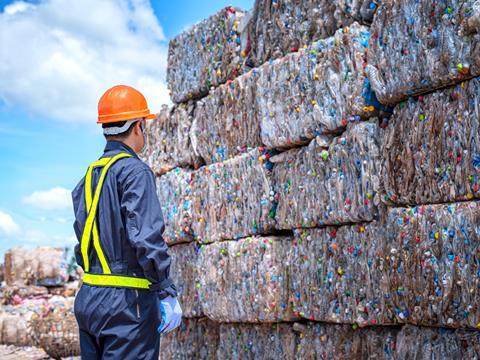
In order to achieve their packaging sustainability goals, brand owners will require far more recycled material than they currently have access to. Michel Weinketz, CEO of Resycure (part of Chemovator), takes a closer look at this tension – and the potential solutions – in our latest opinion piece.
According to “The 2023 Circularity Gap Report” by Circle Economy global circularity has decreased, going from 9.1% in 2018 to, in 2020 to 7.2% in 2023 as a result of increased material extraction. This creates a significant circularity gap because the world relies almost entirely on virgin materials. This indicates that more than 90% of materials are lost, wasted, or permanently locked into a stock that cannot be reused.
From the report, it can be concluded that businesses and policymakers must take immediate action for a circular economy. To accelerate the world’s transition to a circular economy, new business models should be designed by the industry for the industry with long-lasting results.
Actionable and immediate solutions must be taken: The move to recycled plastic
Brand owners are being pressured by legislation and taxes to decrease plastic waste by designing packaging for recycling and using as little virgin plastic as feasible. This reduction is partially accomplished by reducing the weight of the packaging and switching to post-consumer recycled plastic and enhancing the circularity of product packaging are the among main requirements.
To accomplish their 2025 goal, however, more than 60 of the most influential brand owners are anticipated to still require an additional 6 million tonnes of recycled plastic annually. Implementing recycled plastic into packaging is often more expensive and difficult than using virgin plastic – things like regulatory requirements, processing characteristics, and material quality are often top of mind of brand owners and packaging converters. Furthermore, if the market is getting shorter what are the specific challenges for brand owners to purchase and secure volumes of recycled material?
There are five major challenges that nowadays brand owners are currently facing when attempting to buy recycled material in the market.
Intransparent markets create resource-intensive procurement activities
The lack of price transparency in the current market – which recyclers can provide which grade to which volume, combined with a fairly fragmented market and a strong mix of small, medium and a few large players – forces brand owners to invest in upstream procurement capabilities, that can prove time-consuming and expensive, in particular outside their core markets.
Lower procurement volumes from brand owners lead to low priority by recyclers
Many medium and large brand owners have relevant volumes for packaging; however, their PCR resin demand is often relatively low compared to the capacity of a recycling plant and also compared with the biggest brand owners that have huge volumes. This means that recyclers are often not willing to invest in improving processes to meet the quality requirements of companies with low volumes, or push them to the end of the line when a larger volume is available.
Long and complex qualification process
For brand owners and recyclers, there is a long and complex process to identify, test, approve, and control recycled material quality, especially for use in food and cosmetics – this process can easily take over 12 months.
No harmonized specifications for both recyclers and brand owners
There is no “standard” quality requirement for PCR defined for specific applications – each brand owner defines its own, which makes it harder for recyclers to meet a multitude of different specifications for multiple clients. This also makes the procurement process much more complex – it becomes hard to compare products and price proposals.
Long-term demand is not secured
Many recyclers are eager to invest and grow, however, they will not do so without securing long-term demand and relevant volumes to justify their own ROI. Most brand owners are not in the position to offer this security, either because they do not have enough volume in that particular region, or because it is too much of a financial risk to commit to a long-term supply agreement in a “take or pay” contract without knowing how its products will perform in the market.
These five challenges combined create a “chicken and egg” situation, that prevents brand owners and converters to secure the volumes they need and also prevents recyclers to invest and grow.
Solutions for brand owners to overcome challenges to buy recycled plastic and secure their PCR goals
It’s clear that legislation, industry associations, and EPR schemes will play a critical role in changing the situation. That being said, if we want to accelerate the change, we also need pragmatic, market-driven approaches that can deliver solutions in the short term, incentivize recycling and enable brand owners to transition to a circular economy and grow the market faster.
There is a need for neutral players that can work together with brand owners, converters and recyclers to break this chicken-and-egg situation. One example is Resycure, a German venture that is working to break the silos between the relevant players and wants not only to help companies in securing their long-term PCR volumes with no investments or large volume commitments but also leverage that to give security and a positive business case for recyclers to invest.
Start-ups like that and fast-moving companies are in a perfect position to disrupt the market with innovative business models, giving it the boost it needs so badly.
Michel Weinketz is a Brazilian living in Germany for quite some time now. He has over 16 years of experience in the B2B and chemical industry and is one of the founders of Resycure, a startup in the circular economy that is part of Chemovator, the BASF venture incubator program.












No comments yet